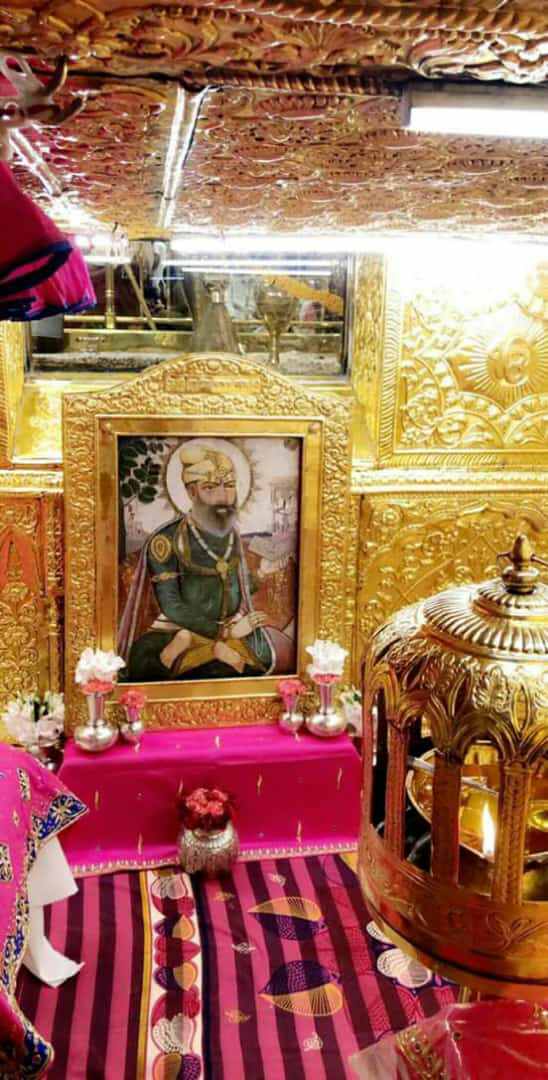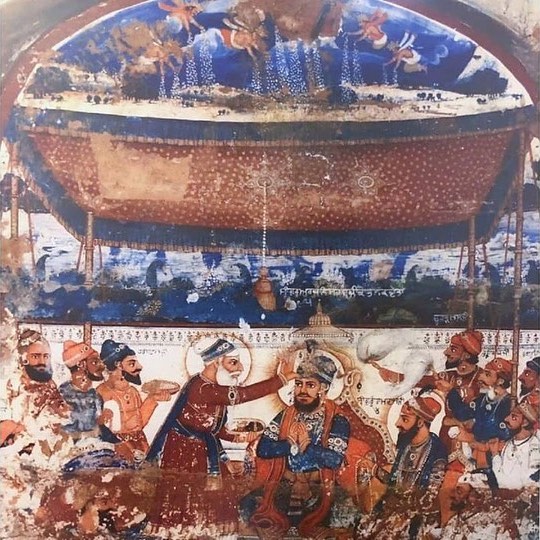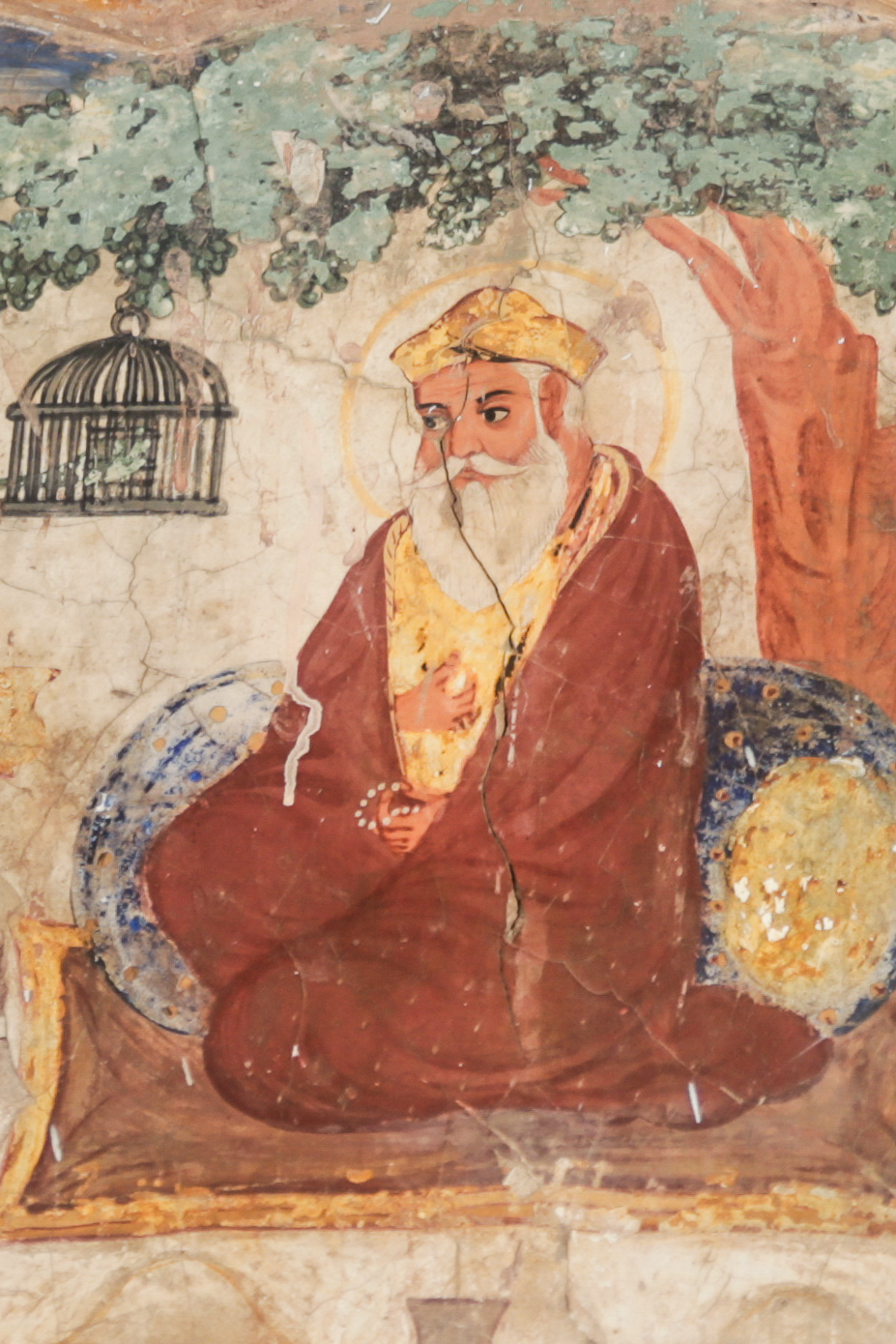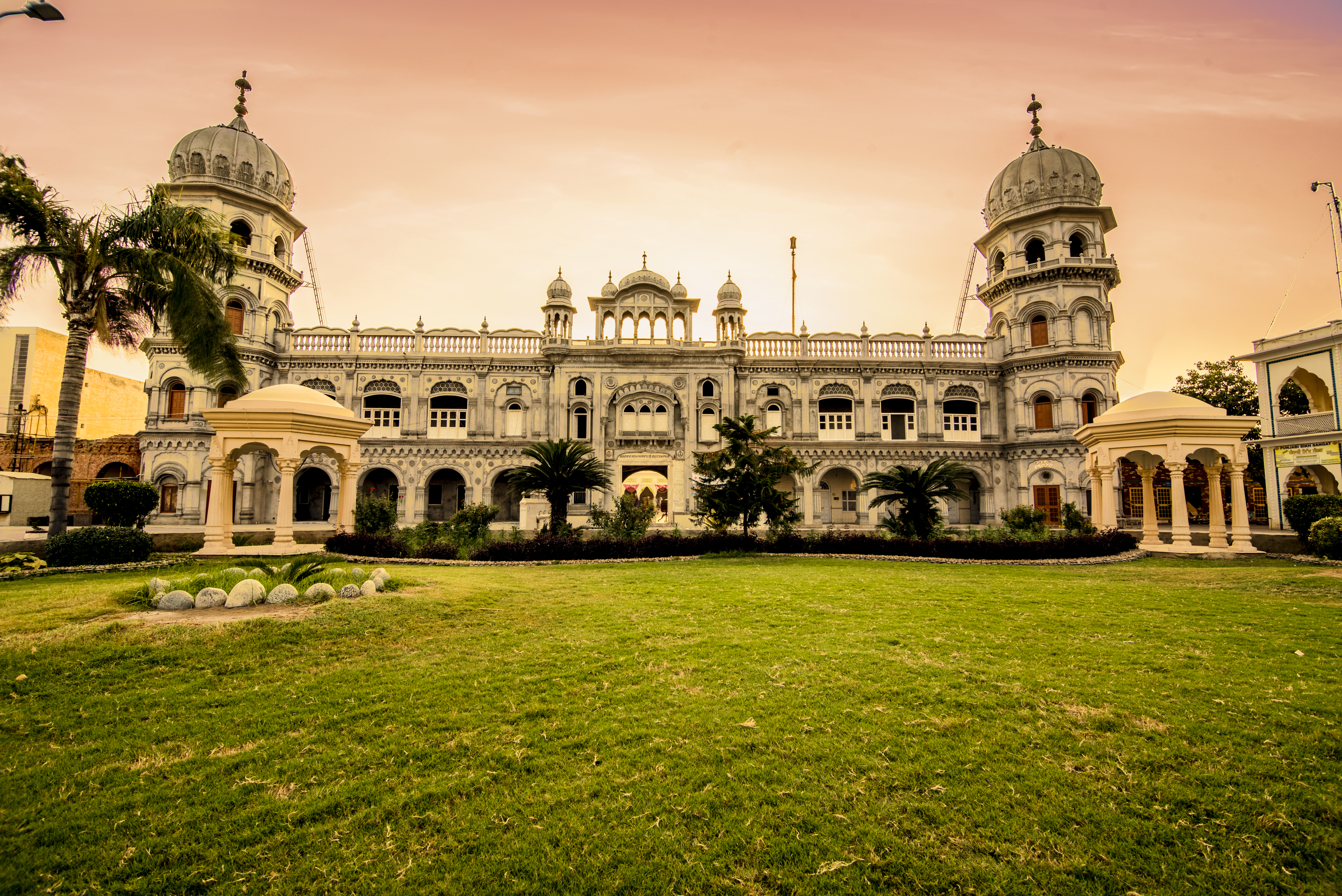|
Akal Sena
The Akal Sena (Gurmukhi: ਅਕਾਲ ਸੈਨਾ; meaning 'Army of the Akal Purakh, Immortal', 'God in Sikhism, God's Army', or 'Eternal Army'; alternatively transcribed as Akaal Sena) was the Sikh military force established by the sixth Sikh gurus, Sikh Guru, Guru Hargobind. It was the first standing Sikh army. It was also known as the Akali Dal. Background During the time period of Guru Arjan, an enemy of the Sikhs and the brother of Arjan, named Prithi Chand, instigated a local Mughal official named Sulahi Khan to destroy the Sikhs and the Guru. Sulahi Khan conjured up an excuse that he was collecting tax to justify him leading a small contingent against the Sikhs at Amritsar. Due to the local residents of Amritsar fearing for their personal safety, Guru Arjan left the city to prevent tragedy. Arjan made his way to Wadali and then from there to Raur. After Wadali was ransacked by Dacoity, bandits, Guru Arjan returned and stayed there for two years to provide security for t ... [...More Info...] [...Related Items...] OR: [Wikipedia] [Google] [Baidu] |
Katar (dagger)
The katar is a type of push dagger from the Indian subcontinent. The weapon is characterized by its H-shaped horizontal hand grip which results in the blade sitting above the user's knuckles. Unique to the Indian subcontinent, it is the most famous and characteristic of Indian daggers. Ceremonial katars were also used in worship. Etymology Having originated in South India, the weapon's earliest name-form was likely the Tamil (). It is alternatively known in Tamil as () which means "stabbing blade". This was adapted into Sanskrit as () or . Due to the schwa deletion in Indo-Aryan languages however, the word often came to be rendered as "katar" in modern Hindi and by extension in colonial transliterations. Other regional names for the weapon include () in Kannada, () in Telugu, () in Malayalam, () in Marathi, , () in Panjabi, and () or in Hindi. History The katar was created in Southern India, its earliest forms being closely associated with the 14th-century Vijayan ... [...More Info...] [...Related Items...] OR: [Wikipedia] [Google] [Baidu] |
Guru Tegh Bahadur
Guru Tegh Bahadur (Punjabi: ਗੁਰੂ ਤੇਗ਼ ਬਹਾਦਰ (Gurmukhi); ; 1 April 1621 – 11 November 1675) was the ninth of ten Gurus who founded the Sikh religion and the leader of Sikhs from 1665 until his beheading in 1675. He was born in Amritsar, Punjab, India in 1621 and was the youngest son of Guru Hargobind, the sixth Sikh guru. Considered a principled and fearless warrior, he was a learned spiritual scholar and a poet whose 115 hymns are included in '' Sri Guru Granth Sahib,'' the main text of Sikhism. Guru Tegh Bahadur was executed on the orders of Aurangzeb, the sixth Mughal emperor, in Delhi, India.;;; Sikh holy premises Gurudwara Sis Ganj Sahib and Gurdwara Rakab Ganj Sahib in Delhi mark the places of execution and cremation of Guru Tegh Bahadur. His martyrdom is remembered as the ''Shaheedi Divas of Guru Tegh Bahadur'' every year on 24 November. Biography Early life Guru Tegh Bahadur was the youngest son of Guru Hargobind, the sixth guru: Gu ... [...More Info...] [...Related Items...] OR: [Wikipedia] [Google] [Baidu] |
Guru Arjan
Guru Arjan (Gurmukhi: ਗੁਰੂ ਅਰਜਨ, pronunciation: ; 15 April 1563 – 30 May 1606) was the first of the two Gurus martyred in the Sikh faith and the fifth of the ten total Sikh Gurus. He compiled the first official edition of the Sikh scripture called the Adi Granth, which later expanded into the Guru Granth Sahib. He was born in Goindval, in the Punjab, the youngest son of Bhai Jetha, who later became Guru Ram Das, and Mata Bhani, the daughter of Guru Amar Das. He completed the construction of Darbar Sahib at Amritsar, after the fourth Sikh Guru founded the town and built a sarovar. Guru Arjan compiled the hymns of previous Gurus and of other saints into Adi Granth, the first edition of the Sikh scripture, and installed it in the Harimandir Sahib. Guru Arjan reorganized the Masands system initiated by Guru Ram Das, by suggesting that the Sikhs donate, if possible, one-tenth of their income, goods or service to the Sikh organization ('' dasvandh''). The ''Mas ... [...More Info...] [...Related Items...] OR: [Wikipedia] [Google] [Baidu] |
Mural Of Guru Hargobind On Horseback While Accompanied By A Flagbearer And Hunting Dog From Gurdwara Chhevin Patshahi, Hadiara, Lahore District (bright Flash Version)
A mural is any piece of graphic artwork that is painted or applied directly to a wall, ceiling or other permanent substrate. Mural techniques include fresco, mosaic, graffiti and marouflage. Word mural in art The word ''mural'' is a Spanish adjective that is used to refer to what is attached to a wall. The term ''mural'' later became a noun. In art, the word mural began to be used at the beginning of the 20th century. In 1906, Dr. Atl issued a manifesto calling for the development of a monumental public art movement in Mexico; he named it in Spanish ''pintura mural'' (English: ''wall painting''). In ancient Roman times, a mural crown was given to the fighter who was first to scale the wall of a besieged town. "Mural" comes from the Latin ''muralis'', meaning "wall painting". History Antique art Murals of sorts date to Upper Paleolithic times such as the cave paintings in the Lubang Jeriji Saléh cave in Borneo (40,000-52,000 BP), Chauvet Cave in Ardèche department of ... [...More Info...] [...Related Items...] OR: [Wikipedia] [Google] [Baidu] |
Sikh Gurus
The Sikh gurus (Punjabi: ਸਿੱਖ ਗੁਰੂ) are the spiritual masters of Sikhism, who established this religion over the course of about two and a half centuries, beginning in 1469. The year 1469 marks the birth of Guru Nanak, the founder of Sikhism. He was succeeded by nine other human gurus until, in 1708, the '' Guruship'' was finally passed on by the tenth guru to the holy Sikh scripture, Guru Granth Sahib, which is now considered the living Guru by the followers of the Sikh faith. Etymology and definition ''Guru'' (, ; sa, गुरु, Punjabi: ਗੁਰੂ, IAST: ''guru'') is a Sanskrit term for a "teacher, guide, expert, or master" of certain knowledge or field. Bhai Vir Singh, in his dictionary of Guru Granth Sahib describes the term Guru as a combination of two separate units: "Gu;(ਗੁ)" meaning darkness and "Rū;(ਰੂ)" which means light. Hence, Guru is who brings light into darkness or in other words, the one who enlightens. Bhai Vir Singh's defi ... [...More Info...] [...Related Items...] OR: [Wikipedia] [Google] [Baidu] |
God In Sikhism
In Sikhism, God is conceived as the Oneness that permeates the entirety of creation and beyond. It abides within all of creation as symbolized by the symbol Ik Onkar. The One is indescribable yet knowable and perceivable to anyone who surrenders their egoism and meditates upon that Oneness. The Sikh gurus have described God in numerous ways in their hymns included in the Guru Granth Sahib, the holy scripture of Sikhism, but the oneness of formless God is consistently emphasized throughout. God is described in the Mul Mantar (lit. the Prime Utterance), the first passage in the Guru Granth Sahib: General conceptions Monotheism Sikhi is Monotheistic and believes that there is only One God. Guru Nanak, the founder of Sikhi strongly denounces any type of ''Pakhand'' (hypocrisy or duality). Nanak prefixed the numeral "IK" (one) to the syllable Onkar to stress the idea of God's oneness; that the Creator, Preserver, and Destroyer is One. Sikh thought begins with the One Almigh ... [...More Info...] [...Related Items...] OR: [Wikipedia] [Google] [Baidu] |
Akal Purakh
Akal Purakh ( pa, ਅਕਾਲ ਪੁਰਖ) is an interchangeable Sikh name used to denote God, or the omnipresent divine. Meaning Literally it means "a timeless being who never dies." The first word '' Akal'', literally "timeless, immortal, non-temporal," is a term integral to Sikh tradition and philosophy. It is extensively used in the Sri Guru Granth Sahib and Dasam Granth hymns by Guru Gobind Singh, who titled one of his poetic compositions Akal Ustat, i.e. "In Praise (ustati) of the Timeless One (akal)". However, the concept of Akal is not peculiar to the Dasam Granth. It goes back to the very origins of the Sikh faith. The term ''Kāl'' refers to "time," with the negative prefix ''a-'' added to render the word ''akal'', meaning "timeless" or "eternal." Purakh refers to "being" or "entity." Together, the two words form the meaning "timeless, eternal being." The word Purakh () is the Punjabi variation of Purusha (). See also * Akal * Ik Onkar * Names of God * Nirankar ... [...More Info...] [...Related Items...] OR: [Wikipedia] [Google] [Baidu] |
Gurmukhi
Gurmukhī ( pa, ਗੁਰਮੁਖੀ, , Shahmukhi: ) is an abugida developed from the Laṇḍā scripts, standardized and used by the second Sikh guru, Guru Angad (1504–1552). It is used by Punjabi Sikhs to write the language, commonly regarded as a Sikh script, Gurmukhi is used in Punjab, India as the official script of the Punjabi language. While Shahmukhi script is used in Punjab, Pakistan as the official script. The primary scripture of Sikhism, the Guru Granth Sahib, is written in Gurmukhī, in various dialects and languages often subsumed under the generic title '' Sant Bhasha'' or ''saint language'', in addition to other languages like Persian and various phases of Indo-Aryan languages. Modern Gurmukhī has thirty-five original letters, hence its common alternative term ''paintī'' or "the thirty-five," plus six additional consonants, nine vowel diacritics, two diacritics for nasal sounds, one diacritic that geminates consonants and three subscript ch ... [...More Info...] [...Related Items...] OR: [Wikipedia] [Google] [Baidu] |
Image Of The Personified Sword, Kalika, Found On The Reputed Tegha (sword) Of Guru Hargobind
An image is a visual representation of something. It can be two-dimensional, three-dimensional, or somehow otherwise feed into the visual system to convey information. An image can be an artifact, such as a photograph or other two-dimensional picture, that resembles a subject. In the context of signal processing, an image is a distributed amplitude of color(s). In optics, the term “image” may refer specifically to a 2D image. An image does not have to use the entire visual system to be a visual representation. A popular example of this is of a greyscale image, which uses the visual system's sensitivity to brightness across all wavelengths, without taking into account different colors. A black and white visual representation of something is still an image, even though it does not make full use of the visual system's capabilities. Images are typically still, but in some cases can be moving or animated. Characteristics Images may be two or three- dimensional, such as a ph ... [...More Info...] [...Related Items...] OR: [Wikipedia] [Google] [Baidu] |
Artwork Of Guru Tegh Bahadur's Name In Perso-Arabic Script With A Tiger Found On The Reputed Tegha (sword) Of His
A work of art, artwork, art piece, piece of art or art object is an artistic creation of aesthetic value. Except for "work of art", which may be used of any work regarded as art in its widest sense, including works from literature and music, these terms apply principally to tangible, physical forms of visual art: *An example of fine art, such as a painting or sculpture. *Objects in the decorative arts or applied arts that have been designed for aesthetic appeal, as well as any functional purpose, such as a piece of jewellery, many ceramics and much folk art. *An object created for principally or entirely functional, religious or other non-aesthetic reasons which has come to be appreciated as art (often later, or by cultural outsiders). *A non-ephemeral photograph or film. *A work of installation art or conceptual art. Used more broadly, the term is less commonly applied to: *A fine work of architecture or landscape design *A production of live performance, such as ... [...More Info...] [...Related Items...] OR: [Wikipedia] [Google] [Baidu] |
Khalsa Fauj
The Khalsa Fauj () were the military forces of the Khalsa order of the Sikhs, established by the tenth Sikh gurus, guru, Guru Gobind Singh, in 1699. It replaced the Akal Sena that had been established by the sixth guru, Guru Hargobind. History Origin Guru Gobind Singh Guru Gaddi, succeeded his father, Guru Tegh Bahadur, as guru in 1675. He felt that the Akal Sena was not living up to the challenge and sought to reform the Sikh military forces. Therefore, it was replaced by the Khalsa Fauj after the formalization of the Khalsa order into the sanctified framework of Sikhism at Anandpur Sahib, Anandpur on 13 April 1699. Guru Gobind Singh had an ultimate vision of Sikh sovereignty. The precedence and authority for establishing the Khalsa Fauj was traced back to the teachings of Guru Nanak. It was committed to freeing the Punjab of Mughal Empire, foreign domination. The army followed the principle of violence only when all other means to address an issue have been exhausted, a p ... [...More Info...] [...Related Items...] OR: [Wikipedia] [Google] [Baidu] |
Sikh Flag
Sikhs ( or ; pa, ਸਿੱਖ, ' ) are people who adhere to Sikhism (Sikhi), a monotheistic religion that originated in the late 15th century in the Punjab region of the Indian subcontinent, based on the revelation of Guru Nanak. The term ''Sikh'' has its origin in the word ' (), meaning 'disciple' or 'student'. Male Sikhs generally have '' Singh'' ('lion'/'tiger') as their last name, though not all Singhs are necessarily Sikhs; likewise, female Sikhs have ''Kaur'' ('princess') as their last name. These unique last names were given by the Gurus to allow Sikhs to stand out and also as an act of defiance to India's caste system, which the Gurus were always against. Sikhs strongly believe in the idea of "Sarbat Da Bhala" - "Welfare of all" and are often seen on the frontline to provide humanitarian aid across the world. Sikhs who have undergone the '' Amrit Sanchar'' ('baptism by Khanda'), an initiation ceremony, are from the day of their initiation known as Khalsa, and they ... [...More Info...] [...Related Items...] OR: [Wikipedia] [Google] [Baidu] |








